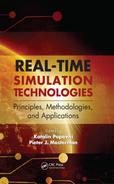Preface
In real-time simulation and optimization, events occur on a natural time scale. Such real-time behavior has become important, if not essential, for a broad spectrum of applications that include embedded system design, control of dynamic processes, online system adaptation, streaming data acquisition, data assimilation for decision making, and operator training.
Over the past decades, commercially available computing power has been on a steady pace to becoming increasingly powerful, affordable, and available. This, in turn, has contributed to the emergence of highly sophisticated simulation software applications that enable high-fidelity real-time simulation of dynamic systems. In such systems, the correctness of behavior depends not only on the logical results of the computations or mathematical algorithms but also on the natural time scale at which these results are produced. As a consequence, it is critically important to preserve the characteristics of system dynamics in a temporal sense.
The advances in computing power have given rise to the emergence of an overwhelming offering of applications where real-time simulation is involved, ranging from simply providing value in some form to having become an absolute necessity. One such example is the national power grid, which is currently in a transformational phase to adapt and support increasingly distributed energy generation in order to facilitate our society’s desire to rely on renewable energy sources for a sustainable future. The envisioned corresponding “smart grid” cannot be realized without essential modifications to the United States grid infrastructure, and to this end, a virtual environment for testing the potential modifications is simply indispensible.*
As another example, in addition to working toward a sustainable future, virtual reality is recognized by the National Academy of Engineering† as one of the grand challenges of engineering for the twenty-first century. For successful virtual reality systems, it is imperative that humans perceive a simulator as if it were part of the natural world. To fully simulate such interaction between computers and humans across the various interface modalities, it is especially critical that sensations of sound, touch, and motion are produced in real time.
The broad area of cyber-physical systems‡ exemplifies another application domain of real-time simulation. As these systems represent computer-synthesized environments that integrate computation and physical processes, simulation environments must operate in real time if they are to encapsulate and capture cyber and physical characteristics of the systems in one unified framework.
Advanced design methods are rapidly becoming the key enabler of highly competitive industries, and real-time simulation performs a key role here as well. For example, in the aerospace industry, computational modeling and simulation help identify critical items and assist in feasibility studies and design space exploration.* The value and benefit of such simulations rely to a large extent on the quality of the mathematical models and how well they capture system behavior in the physical world. This necessitates real-time simulation of sophisticated models that represent systems ranging from, for example, electromechanical components to entire subsystem with complex embedded computation.
* http://www.eweek.com/c/a/IT-Infrastructure/Smart-Grids-Growing-to-a-96-Billion-Market-by-2015-172497/
† http://www.engineeringchallenges.org/
‡ http://www.nitrd.gov/Pcast/reports/PCAST-NIT-FINAL.pdf
All these applications are testimony to the importance and timeliness of a collection of chapters dedicated to real-time simulation that comprises prominent and insightful achievements in the field. This book intends to facilitate, and compiles highly acclaimed real-time simulation material from a variety of different domains such as pure simulation algorithms, distributed systems, and real-time systems. The collection of contributions is intended to serve as the basis of a comprehensive and cohesive approach for real-time simulation. The synergy between the different application domains in concert with the foundational theories, methodologies, and technologies then sets the stage for enabling the next-generation real-time simulations. Each chapter contributes supreme results that have helped firmly establish their respective real-time simulation technologies, applications, and tools and that continue to remove barriers and expand the bounds of real-time simulation. The contributing authors excel in their expertise, and we are as much delighted as we are honored by their participation in the effort that lead to this book. We sincerely hope that the readers will find the indulgence of intellectual achievement as enjoyable and stimulating as we do.
In closing, we would like to express our genuine thankfulness and appreciation for all the time and effort that each of the authors has invested. Our truly pleasant collaboration has certainly helped make the completion of this project as easy as possible. In addition to the authors who contributed but also reviewed other chapters, we are gratefully indebted to external reviewers who took on the essential task of providing constructive feedback and helped realize the exceptional quality that we set out to achieve. Of course, none of this would have been possible without the continuous and wonderful support of the team at Taylor & Francis, especially our publisher, Nora Konopka, and the staff involved in the verification and production process. Many thanks to each of you!
MATLAB® is a registered trademark of The MathWorks, Inc. For product information, please contact:
The MathWorks, Inc.
3 Apple Hill Drive
Natick, MA 01760-2098 USA
Tel: 508 647 7000
Fax: 508-647-7001
E-mail: [email protected]
Web: www.mathworks.com
* ten Dam, A. A., and J. Kos. 1999. “Real-time simulation of impact for the aerospace industry.” Report no. NLR-TP-99289, National Aerospace Laboratory NLR, Amsterdam, the Netherlands.
